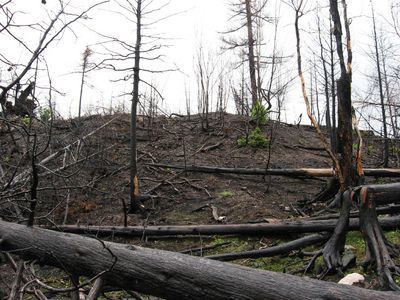The big — and getting bigger — wildfire in the Boundary Waters is sure to ignite an old debate: When should the Forest Service just let it burn?
Let’s hit rewind and check the excellent Duluth Pack Blog, and its August 31 entry, when the fire was still in its infancy:
The Forest Service strategy is to let this fire burn as long as it is not threatening BWCAW campsites, portages, or private properties to the north. Controlled burn strategies are common when fires are started naturally and don’t pose risk to life or property. As this fire burns it is removing or reducing much of the fuel that is lying on the ground; by eliminating that now, future fires won’t have fuel to burn.
Today, Eric Thompson of Green Bay — an MPRNews.org reader — sent us this e-mail:
I was hiking the Pow-Wow Trail from 09-02-2011 to 09-05-2011. I was four miles from the fire. This fire started on 08-18-2011 by lightning and the US Forestry Service made the decision to let it burn. They say it’s good for the wilderness to clean out all the downed wood. Day 1 it was 18 acres, day 3 it was 240 acres. When I started hiking on 09-02 it was over 1000 acres. Now its over 60,000. The USFS needs to jump on top of these fires before letting them grow out of control. Then they whine about the damage they cause when they are to blame for letting it grow in the first place?
The Forest Service began changing its policy toward fire in 1995, when the environmental benefit of fire to a forest became more known, and the cost of suppressing it went up.
Fire clears out underbrush and creates forest openings, which in the long run prevents — wait for it — large fires.
The policy had its root in the fact that in the early part of this century, the more effort was made to extinguishing wildfires, the more wildfires there were.
“The mentality is changing,” Greg Aplet, a Denver-based fire scientist with The Wilderness Society, told USA Today in 2007, a huge year for wildfires in the U.S. “The obvious answer is not to fight fires we don’t need to fight.”
But how do you know for sure which fires those are? Except in the most wild of areas, it becomes a gamble that the weather patterns won’t promote a significant spread of the fire to the point where homes and businesses are threatened.
We’ve reached that point.
“The smoke from Pagami Creek has been particularly heavy this Tuesday morning in and around Grand Marais,” Paula Marie Powell tells MPR News today. “As a manager at a hotel, I have been checking guests out days before their departure date because of smoke complaints. Cars and deck chairs are covered in ash. Some of the local homeowners have been checking and running their sprinkler systems. The drought conditions are making people anxious, as we all know that it barely takes an effort to start a wildfire right now.”
Last week, an environmental group in Oregon filed suit against the Forest Service to require an environmental assessment before deciding whether to fight fires, including considering the cost of human life.
“The thesis of our case is that fighting fires is what has gotten us into the trouble we’re in,” said Andy Stahl, executive director of Forest Service Employees for Environmental Ethics. “It’s time to end the war against fire and learn to live with fire and manage it, rather than fight it.”
One of those filing the suit was the father of man who died fighting the Thirty Mile Fire in Washington in 2001.
“It’s one thing to die in the service of your country for a justifiable proper cause,” Ken Weaver told the Seattle Times. “The problem is we’ve got these kids out there dying for something that is scientifically bankrupt. We are subverting nature, causing more damage than good, and we are taking kids’ lives. That is just so wrong.”
(This information was incorrect. I regret the error)
(Photo: Julie Miedtke’s 2007 photo of the area of the Cavity Lake Fire via Flickr)

